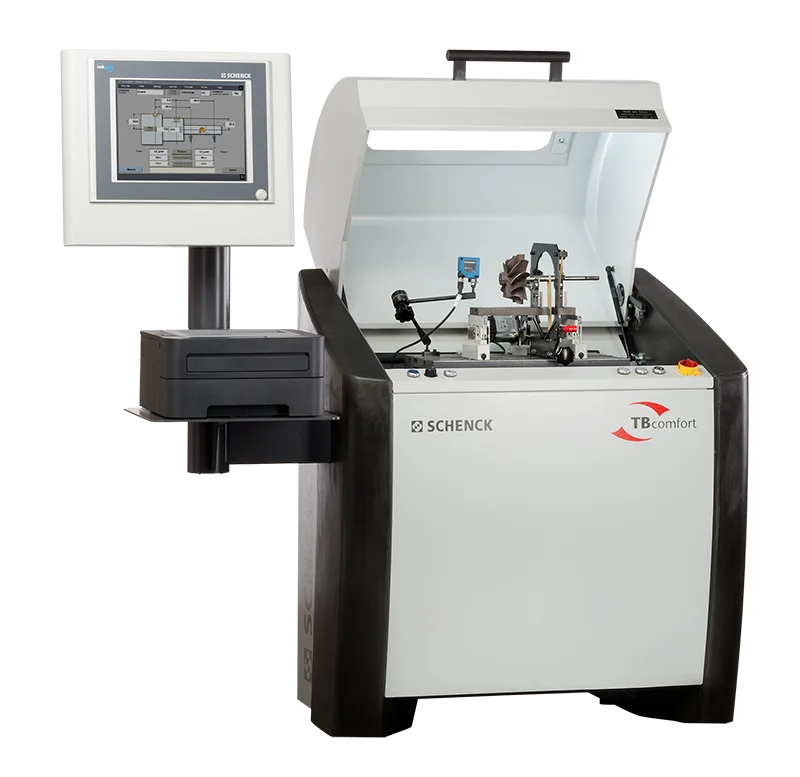Balancing the Turbo

Here at MuchBoost, we make sure to balance every single one of our turbos using a VSR balancing process.
Why do I want a balanced turbo?
The VSR balancing procedure aims to reduce noise and increase bearing life by controlling a turbo’s vibration level. The cause of turbo noise is the transmission of engine vibration from the turbo to the engine through the turbine housing and exhaust mounting, which causes the engine’s components and pipework to vibrate and emit sound into the environment, which is commonly described as a “wolf howl.” High amounts of this vibration force might result in excessive loading and early bearing failure because it is initially transmitted through the turbo bearings.
As a result, vibration is the most important characteristic to manage, and the process’ main goal is to lower vibration to a level that produces a CHRA that operates quietly and does not over-load its bearings, thus making sure the turbo works properly as long as possible.
Why do we balance the turbos?
Making sure that the rotating turbocharger components are properly balanced is one of the most crucial aspects of creating a turbocharger that will run quietly and effectively for a long period. The issue is that a lot of people are unaware of what “fully balanced” actually entails.
Imbalance is typically represented as the weight times the radius formula. A balanced part is said to be 1 gram-inch out of balance if a 1 g weight is placed on it at a one inch radius. Tolerances for contemporary turbochargers are sometimes stated in milligram inches or thousandths of a gram-inch. For instance, component balancing tolerances for the Garrett T-3 and T-4 frame turbos are typically around.010 gram inches (10 milligram inches).
Component versus assembly balance is one area of turbo balancing that causes confusion. The rotating assembly of a turbocharger is made up of various turbo component elements that are assembled. Only the Turbine and Compressor Wheels are balanced out of all these turbo components. Prior to construction, these components must be balanced, which is crucial. The mechanical fit of the axial thrust spacers and compressor locknut is restricted by the machining tolerance restrictions since they are not balanced. A certain degree of “stackup” unbalance is added to the finished turbo when these parts are joined.
Stackup imbalance has gained importance as compact turbos become more widely used in automotive applications. Due to these small units’ low mass and fast rotational speeds, balancing the Turbo Components to an excessively tight tolerance might not be sufficient. Oil leaking from the ends of the bearing housing and “screaming,” an imbalance-induced vibration of the turbo rotating assembly, are common signs of a mildly imbalanced little turbo. Trim balancing the moving components of the built Turbo CHRA is the quickest and most efficient way to eliminate the stackup imbalance that results in these issues (center housing rotating assembly).
In conclusion, every turbo should be balanced in order to ensure proper, and longest possible operation. We 100% agree with that statement and do our best to provide the most precise service.
At MuchBoost we use Schenck and Cimat balancing machines.
Every turbo that leaves our workshop has a high-speed balancing protocol, which means you can be sure that the turbo you get is up to the highest standards.
This is one of the machines we use at our workshop:
-
1.5 T4 Hybrid Turbo Upgrade Alfa Romeo Tonale 1301999,00 €Add to WishlistAdd to Wishlist
-
1.6D EJK Hybrid Turbo Upgrade Alfa Romeo Giulietta 1.6 JTDM, Fiat 500L, 500X, Doblo II, Tipo II 1.6 Multijet, Jeep Compass II, Renegade 16CRD1299,00 € – 1599,00 €Add to WishlistAdd to Wishlist
-
D19AA 1.9 JTDM/Multijet Hybrid Turbo Upgrade Alfa Romeo 159, Fiat Grande Punto, Sedici, Suzuki SX4 1.9 DDiS1199,00 € – 1399,00 €Add to WishlistAdd to Wishlist
-
1.3D B13DTE Hybrid Turbo Upgrade Opel Combo, Corsa E, Lancia Musa, Fiat 500, Panda, Qubo, Tipo, Alfa Romeo MiTo1349,00 €Add to WishlistAdd to Wishlist
-
Alfa Romeo Giulia/Stelvio Quadrifoglio Custom De-Cat/Sport-Cat Downpipe 2.9 V6 BiTurbo1574,40 € – 3382,50 €Add to WishlistAdd to Wishlist
-
1.6JTDM/Multijet Hybrid Turbo Upgrade Alfa Romeo MiTo, Fiat 500L, Bravo II, Grande Punto, Punto EVO, Idea, Lancia Delta III, Musa I949,00 € – 1039,00 €Add to WishlistAdd to Wishlist
-
1.3 Multijet Hybrid Turbo Upgrade Alfa Romeo MiTo 1.3JTDM, Fiat Doblo, Grande Punto, Idea, Linea, Lancia Musa, Ypsilon1099,00 €Add to WishlistAdd to Wishlist
-
1.5 VGT Hybrid Turbo Upgrade Alfa Romeo Tonale 48V1999,00 €Add to WishlistAdd to Wishlist
-
2.4 JTDM Hybrid Turbo Upgrade Alfa Romeo 159, Brera, Spider, Fiat Croma II1099,00 € – 1299,00 €Add to WishlistAdd to Wishlist








